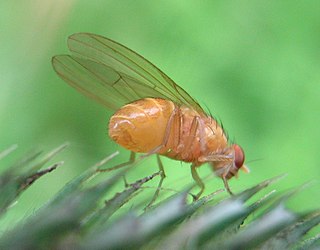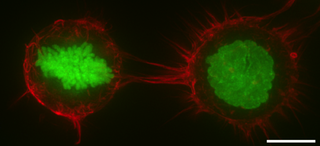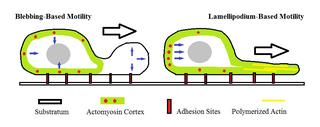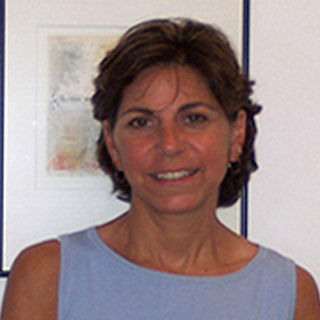Related Research Articles

Biology – The natural science that studies life. Areas of focus include structure, function, growth, origin, evolution, distribution, and taxonomy.

The cell cortex, also known as the actin cortex, cortical cytoskeleton or actomyosin cortex, is a specialized layer of cytoplasmic proteins on the inner face of the cell membrane. It functions as a modulator of membrane behavior and cell surface properties. In most eukaryotic cells lacking a cell wall, the cortex is an actin-rich network consisting of F-actin filaments, myosin motors, and actin-binding proteins. The actomyosin cortex is attached to the cell membrane via membrane-anchoring proteins called ERM proteins that plays a central role in cell shape control. The protein constituents of the cortex undergo rapid turnover, making the cortex both mechanically rigid and highly plastic, two properties essential to its function. In most cases, the cortex is in the range of 100 to 1000 nanometers thick.

In cell biology, a bleb is a bulge of the plasma membrane of a cell, characterized by a spherical, "blister-like", bulky morphology. It is characterized by the decoupling of the cytoskeleton from the plasma membrane, degrading the internal structure of the cell, allowing the flexibility required for the cell to separate into individual bulges or pockets of the intercellular matrix. Most commonly, blebs are seen in apoptosis but are also seen in other non-apoptotic functions. Blebbing, or zeiosis, is the formation of blebs.
Dame Frances Mary Ashcroft is a British ion channel physiologist. She is Royal Society GlaxoSmithKline Research Professor at the University Laboratory of Physiology at the University of Oxford. She is a fellow of Trinity College, Oxford, and is a director of the Oxford Centre for Gene Function. Her research group has an international reputation for work on insulin secretion, type II diabetes and neonatal diabetes. Her work with Andrew Hattersley has helped enable children born with diabetes to switch from insulin injections to tablet therapy.
Gillian Patricia Bates FMedSci FRS is a British biologist. She is distinguished for her research into the molecular basis of Huntington's disease and in 1998 was awarded the GlaxoSmithKline Prize as a co-discoverer of the cause of this disease. As of 2016, she is Professor of Neurogenetics at UCL Institute of Neurology and the co-director of UCL Huntington's Disease Centre.

Amoeboid movement is the most typical mode of locomotion in adherent eukaryotic cells. It is a crawling-like type of movement accomplished by protrusion of cytoplasm of the cell involving the formation of pseudopodia ("false-feet") and posterior uropods. One or more pseudopodia may be produced at a time depending on the organism, but all amoeboid movement is characterized by the movement of organisms with an amorphous form that possess no set motility structures.
Thomas Dean Pollard is a prominent educator, cell biologist and biophysicist whose research focuses on understanding cell motility through the study of actin filaments and myosin motors. He is Sterling Professor of Molecular, Cellular & Developmental Biology and a professor of cell biology and molecular biophysics & biochemistry at Yale University. He was dean of Yale's Graduate School of Arts and Sciences from 2010 to 2014, and president of the Salk Institute for Biological Studies from 1996 to 2001.
The UCL Faculty of Life Sciences is one of the 11 constituent faculties of University College London (UCL).
Judith Patricia Armitage is a British molecular and cellular biochemist at the University of Oxford.

Klaus Weber was a German scientist who made many fundamentally important contributions to biochemistry, cell biology, and molecular biology, and was for many years the director of the Laboratory of Biochemistry and Cell Biology at the Max Planck Institute for Biophysical Chemistry in Göttingen, Germany.

Jonathan Felix Ashmore is a British physicist and Bernard Katz Professor of Biophysics at University College London.

Stuart Graham Cull-Candy is a British neuroscientist. He holds the Gaddum Chair of Pharmacology and a personal Chair in Neuroscience at University College London. He is also a member of the Faculty of 1000 and holds a Royal Society - Wolfson Research position.

Diane L. Barber is an American cell biologist. She is an Endowed Professor and Chair of the Department of Cell and Tissue Biology at University of California, San Francisco (UCSF) and an elected American Association for the Advancement of Science fellow in recognition of her "distinguished contributions on cell signaling by plasma membrane ion transport proteins and on the design and function of proteins regulated by intracellular pH dynamics." In addition to teaching graduate and professional students and her administrative service, she directs a research laboratory funded by grants from the National Institutes of Health (NIH) and the National Science Foundation (NSF).
Bernice Grafstein Shanet is a Canadian neurophysiologist, a professor at Weill Cornell Medical College in New York and a noted specialist in neuroregeneration research. Shanet is a Professor of Physiology and Biophysics at Weill Cornell Medical College, the holder of the Vincent and Brooke Astor Distinguished Professorship in Neuroscience at Weill Cornell Medical College, the Professor of Neuroscience for the Brain and Mind Research Institute at Weill Cornell Medical College and the first woman ever to serve as president of the American Society for Neuroscience. Shanet is famous for her studies of the transport of materials down the axon nerves and her thesis work on the mechanism of cortical spreading depression, which became a classic in its field and is acknowledged even today.

Roger Sidney Goody is an English biochemist who served as director at the Max Planck Institute for Molecular Physiology in Dortmund from 1993 until 2013. Since 2013 he is Emeritus Director of the institute.

Anne Jacqueline Ridley is professor of Cell Biology and Head of School for Cellular and Molecular Medicine at the University of Bristol. She was previously a professor at King's College London.

Casper Hoogenraad is a Dutch Cell Biologist who specializes in molecular neuroscience. The focus of his research is the basic molecular and cellular mechanisms that regulate the development and function of the brain. As of January 2020, he serves as Vice President of Neuroscience at Genentech Research and Early Development.
Beatriz Rico is a professor of developmental neurobiology at King's College London. Her research focuses on neural circuit development.

Elaine Yih-Nien Hsiao is an American biologist who is Professor in Biological Sciences at University of California, Los Angeles. Her research considers the microbes that impact human health. She was a 2022 Laureate for the Blavatnik Awards for Young Scientists.
Yanlan Mao is a British biologist who is a professor at University College London. Her research considers cell biology and the molecular mechanism that underpin tissue formation. She was awarded the Royal Microscopical Society Medal for Life Sciences in 2021.
References
- ↑ "Ewa Paluch | Blavatnik Awards for Young Scientists". blavatnikawards.org. Retrieved 2019-07-05.
- ↑ UCL (2017-07-31). "Paluch_Biography". UCL. Retrieved 2019-07-10.
- ↑ Paluch, Ewa K.; Salbreux, Guillaume; Charras, Guillaume; Roux, Philippe P.; Anan Ragab; Dierkes, Kai; Cassani, Davide A. D.; Smith, Matthew B.; Clark, Andrew G. (2017). "Actin cortex architecture regulates cell surface tension". Nature Cell Biology. 19 (6): 689–697. doi:10.1038/ncb3525. ISSN 1476-4679. PMC 5536221 . PMID 28530659.
- ↑ Pells, Rachael (2019-04-11). "Interview with Ewa Paluch". Times Higher Education (THE). Retrieved 2019-07-11.
- ↑ "Prof Ewa K Paluch — Department of Physiology, Development and Neuroscience". www.pdn.cam.ac.uk. Retrieved 2019-07-10.
- ↑ "Trinity Fellow, Ewa Paluch, Wins Blavatnik Award in the Life Sciences". Access Industries. 9 January 2019. Retrieved 2019-07-11.
- ↑ "New members greeted in Heidelberg". EMBO. 19 December 2018. Retrieved 2019-07-11.
- ↑ "Hooke Medal Winner 2017: Ewa Paluch". British Society for Cell Biology. Retrieved 2019-07-11.